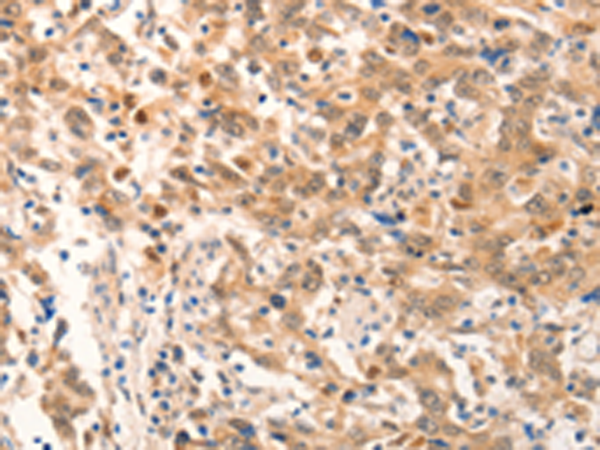
| WB | 咨询技术 | Human,Mouse,Rat |
| IF | 咨询技术 | Human,Mouse,Rat |
| IHC | 1/25-1/100 | Human,Mouse,Rat |
| ICC | 技术咨询 | Human,Mouse,Rat |
| FCM | 咨询技术 | Human,Mouse,Rat |
| Elisa | 1/2000-1/5000 | Human,Mouse,Rat |
| Aliases | KOX, KOX-1, RENOX |
| Host/Isotype | Rabbit IgG |
| Antibody Type | Primary antibody |
| Storage | Store at 4°C short term. Aliquot and store at -20°C long term. Avoid freeze/thaw cycles. |
| Species Reactivity | Human, Mouse, Rat |
| Immunogen | Fusion protein of human NOX4 |
| Formulation | Purified antibody in PBS with 0.05% sodium azide and 50% glycerol. |
+ +
以下是3-4条关于NOX4抗体的参考文献及其摘要概括:
1. **文献名称**:*"NOX4 Activity Is Determined by mRNA Levels and Reveals a Unique Pattern of ROS Generation"*
**作者**:Bedard K, Krause KH
**摘要**:该研究通过Western blot和免疫组化验证了NOX4抗体的特异性,发现NOX4的活性与其mRNA水平直接相关,并揭示了其在细胞氧化应激中产生的活性氧(ROS)具有独特的亚细胞定位和信号调控模式。
2. **文献名称**:*"Nox4 Is a Protective Reactive Oxygen Species Generating Vascular NADPH Oxidase"*
**作者**:Dikalov S, Griendling KK
**摘要**:研究利用特异性NOX4抗体检测其在血管平滑肌细胞中的表达,证明NOX4通过产生过氧化氢(H₂O₂)而非超氧化物,在维持血管稳态和抗氧化应激中发挥保护性作用。
3. **文献名称**:*"The NADPH Oxidase Subunit NOX4 Is a New Target Gene of the Hypoxia-Inducible Factor-1"*
**作者**:Block K, Gorin Y
**摘要**:该文献通过免疫沉淀和免疫荧光技术,证实HIF-1α在缺氧条件下直接调控NOX4的表达,并利用NOX4抗体揭示其在糖尿病肾病中促进氧化损伤和纤维化的分子机制。
4. **文献名称**:*"NOX4-mediated ROS signaling in cancer progression and therapy resistance"*
**作者**:Cheng G, Diebold L
**摘要**:研究通过NOX4抗体检测肿瘤组织中的表达,发现其通过ROS介导的上皮-间质转化(EMT)促进肿瘤转移,并探讨了靶向NOX4在克服癌症治疗耐药性中的潜力。
以上文献均涉及NOX4抗体的实验应用(如Western blot、免疫组化等),并聚焦于NOX4在不同病理生理过程中的作用机制。
NOX4 (NADPH oxidase 4) is a member of the NADPH oxidase family, which generates reactive oxygen species (ROS) as part of cellular signaling and oxidative stress responses. Unlike other NOX isoforms, NOX4 is constitutively active and produces hydrogen peroxide (H₂O₂) rather than superoxide, due to its unique structural features, including six transmembrane domains and a dehydrogenase region. It is widely expressed in tissues such as the kidneys, blood vessels, and lungs, where it regulates processes like fibrosis, inflammation, and apoptosis. Dysregulation of NOX4 has been implicated in various pathologies, including hypertension, diabetic nephropathy, cancer, and cardiovascular diseases, making it a key target for mechanistic and therapeutic studies.
NOX4 antibodies are essential tools for detecting and quantifying NOX4 protein levels in research. They enable the study of its expression patterns, subcellular localization, and interaction partners via techniques like Western blotting, immunohistochemistry, and immunofluorescence. Given the high homology among NOX family members, specificity is a critical consideration. High-quality NOX4 antibodies are validated to minimize cross-reactivity with NOX1. NOX2. or other isoforms. Researchers also use these antibodies to explore NOX4's role in disease models, such as its pro-fibrotic effects in organ fibrosis or its dual roles in cancer progression. Recent advancements include isoform-specific antibodies and those targeting post-translational modifications, aiding in understanding NOX4's regulatory mechanisms. Validation via knockout controls or siRNA remains crucial to confirm antibody reliability in experimental settings.
×